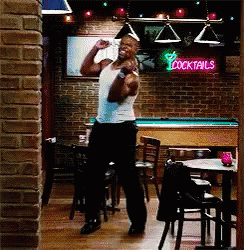What Your Choice Of GIF Reveals About Your Personality

They might seem like a small part of online communication, but your GIF use can say a lot about you.
GIFs are a window into your personal social media ethics — how you communicate what you think is right and wrong, and what’s okay for you to say online. Choosing the right GIF at the right time to express the right feeling can be a complex form of cultural engagement, and it can also be deeply political.
Do you deliberately choose GIFs from TV shows you’ve seen or cultural references you’re familiar with, or do you go on face value? Do you represent yourself with people who look like you? Do you credit the creator of the GIFs you share, or do you think popular content just “belongs to the internet”?
Do you scroll through the skin colour options for emojis, or just leave them default yellow?
What Your GIF Choice Says About You
When we choose a GIF, it might seem like a decision that’s only important on a minor, interpersonal scale. But as we use social media to get our news, be entertained, argue, chat, and check in, we’re becoming part of a broader media landscape in which some voices are amplified, while others are ignored.
A recent article in Teen Vogue controversially stated that sharing GIFs of black people’s exaggerated reactions is a form of “digital blackface” that contributes to enduring stereotypes of black people being associated with excessive behaviours. GIFs are also an important way that young women connect over intimate snapshots of their life, and there’s considerable skill in blending the personal and the generic to create a relatable moment.
Platforms like Twitter and Facebook are adding GIF keyboards so people can send more GIFs more often, while the Australian government has told public servants they can come under fire for liking or sharing posts with “objectionable material” on social media.
Clearly, these microcosms of culture matter. We make GIFs meaningful by the way we choose, contextualise, and share them, and they’re especially powerful when we use them to represent ourselves.
With that in mind, let’s take a look at three commonly used GIFs, and what they might actually be saying:
The Gif:

What it looks like: A blonde guy with a mullet and yellow t-shirt looking surprised and saying “what the fuck”
Where it’s from: The 1974-themed video clip for Blink-182’s song First Date, in which singer Tom DeLonge reacts to seeing a girl fall off her bicycle and injure herself.
What it might mean: You’re surprised; you’re disgusted; you’re trying to swear without actually typing a swear word. “What the fuck” isn’t part of the song’s lyrics, and Tom doesn’t audibly say it, but his silent mouthing couldn’t be clearer. It’s an excellent GIF because of this fact: in both the clip and the GIF, the words remain silent. It might also say something about your age: Blink-182, along with Pokémon, Spongebob Squarepants, and Friends, are all part of late 90s/early 00s culture, putting you around your late 20s if they’re bands and shows you GIF because you and your peers get the reference.
The GIF(s):
What it looks like: A beardy guy at the cinema in a hoodie and jacket looking alternately delighted, embarrassed, and bored.
Where it’s from: Actor Shia LaBeouf spent 72 straight hours being filmed watching his own movies in live-streamed performance art piece #AllMyMovies in 2015. His reactions were considered especially shareable, and perhaps even deliberately staged for their potential to be used online: “The feed basically boils down to Shia being a human emoji”.
What it might mean: You’re also watching a movie that has given you some feelings; you love a good meta-joke, since these GIFs show Shia reacting to his own image; you’re inadvertently perpetuating the idea that the core demographic of the internet is white American men, since they feature so often in the images we share.
The GIF:

What it looks like: A man wearing a singlet, beaming, exuberantly dancing in a bar
Where it’s from: An episode of police sitcom Brooklyn Nine-Nine, in which actor Terry Crews, playing Sergeant Terry Jeffords, has reluctantly agreed to have one drink with an old colleague. The scene cuts forward to “one drink later”: he leaps off a table, dancing to Sisters Are Doin’ It For Themselves, shouting, “my tolerance has really changed since I had kids!”
What it might mean: You’re joyful; you’re celebrating; you’re a new parent; you haven’t thought about the way this image might reinforce existing racial ideas.
Think Before You GIF
Despite the way they seem to circulate freely online, the origins of GIFs and memes can be compelling. Resources like the enormous collection of stories behind internet phenomenon Know Your Meme, or articles that trace a highly circulated image back to its source, get a lot of online traffic.
I’m not saying that each reaction GIF we include in a tweet or Facebook message needs to be meticulously researched, or that we can only represent ourselves online with people who look like us. Sometimes they don’t need a meaning any deeper than “that guy in the Australia’s Got Talent audience looks really, really, really impressed”.

But as long as we use GIFs to communicate our culture and ourselves, they’re worthy of having a think about.
—
Emily van der Nagel is an academic who writes, teaches, and speaks about social media identities and culture. She tweets about research and GIFs at @emvdn.